“With one bound they were free!” Or was Barbenheimer two bounds? Either way, you cannot fail to have heard that the conjoined release of Greta Gerwig’s Barbie and Christopher Nolan’s Oppenheimer has saved cinema. Crisis managers can go home. It’s 1939 again. The medium is back at the heart of the cultural conversation.
In Ireland alone, the two films took in €3.93 million last weekend. Barbie grabbed $337 million (€304 million) at the world box office. Oppenheimer, a sombre film much focused on nuclear physics, accumulated around $174 million (€157 million). Barbie’s $155 (€140) million in the US passed out Marvel sequels, Mission: Impossible retreads and Super Mario Bros to score the biggest opening of the year. And so on.
Might a conservative industry conclude it is time to give the public what it doesn’t already know it wants? We can hope
Someone, somewhere is arguing it is all empty hype. Audiences are sheepishly responding to online prodding from acquiescent influencers. Right? It is certainly true that the Barbenheimer phenomenon – partly organic, partly engineered – has helped both films exceed early expectations. The marketing behind Barbie has been particularly ingenious. Initially dismissed unseen as a shameless concession to commerce, the film arrived at cinemas as an unstoppable cult sensation (and is now more than that). But the evidence suggests audiences are not disappointed. Exiting punters, polled by the CinemaScore marketing research firm, gave both titles an “A” rating.

By a happy coincidence, four days after Barbenheimer landed, the Venice Film Festival – traditional gateway to awards season – announced an indecently intriguing programme. Michel Fassbender in David Fincher’s The Killer. Adam Driver plays Enzo Ferrari for Michael Mann. Bradley Cooper plays Leonard Bernstein in his own film. The industry is driving up and down Sunset Boulevard honking its collective horn and letting off party poppers. Those hazy-crazy days of summer! Days of soda and pretzels and beer!
READ MORE
It is, of course, not like that at all. Despite the good news last weekend, the industry is still struggling with an existential crisis to compare to that which accompanied the arrival of television in the 1950s. Most reports on the Venice announcement expressed surprise that the continuing Hollywood actors strike had not more disrupted the organisers’ plans. It had already been confirmed that Luca Guagadino’s Challengers, originally scheduled as the opening film, would no longer play by the Lido and that its release had been moved from mid-September to April of 2024.
Variety, the industry bible, further suggested that Warner Bros, the studio distributing Challengers, could delay upcoming titles such as Dune: Part Two, Aquaman and the Lost Kingdom, and the musical version of The Colour Purple. The union’s prohibition on promotional activities is seen as a drag on those films’ box office prospects. (It is easy to scoff. But think what a part Margot Robbie played in the pre-release push for Barbie.) Studios will also worry that shooting delays due to strike action may ultimately lead to holes in the release calendar for 2024 and 2025. Some sort of rearrangement is inevitable.
The strike itself will end (though probably not soon). What matters to the wider argument are the structural and technical alterations that have driven a wedge between workers and management. SAG-AFTRA, the actors’ union, and the WGA, representing striking writers, have a host of grievances, but the thorniest concern fair recompense for their work on streaming releases. In an extraordinarily brief period, Netflix, Prime Video, Apple TV+ and the rest have caused even greater disruption to the big screen than TV managed during the Eisenhower era. For the succeeding half-century it remained more or less clear that cinema and television were distinct businesses. Nobody mistook a TV movie for a “proper film”. It wasn’t just that the former almost never appeared in cinemas; the two genres worked to different vocabularies and grammars. In 2022, just a decade after Netflix began original programming, Apple TV+’s Coda became the first feature from a streamer to win best picture at the Academy Awards. Those lines are blurred.
[ Netflix sits pretty as Hollywood frets about strikesOpens in new window ]
The streaming services were inevitable winners during the pandemic. Barbenheimer is far from the first phenomenon to have “saved cinema” over the past three years.

The indestructible James Bond had a crack with No Time to Die in 2021. Spider-Man: No Way Home passed the magic $1 billion just a few months later. To this point, the most heralded saviour was Tom Cruise and Top Gun: Maverick. The actor resisted all pleas to release the film in the penumbra of lockdown or to send it straight to a streaming service. It eventually arrived, three years after shooting ended, in the summer of 2022 and cleaned up with a colossal $1.5 billion.
And yet. Few in the industry buy the argument that complete recovery is imminent. Around 75 per cent of movie professionals polled by Variety last month believed it would be at least five years before box-office surpassed pre-pandemic highs. Almost half thought the figures would get worse. True, this was before Barbenheimer. But it was also before the strike.
There have been hits this year. The Super Mario Bros Movie is (no, really) the 16th highest grossing film of all time – and could still go higher. Guardians of the Galaxy Vol 3 has done reasonably well. The fine Spider-Man: Across the Spider-Verse has exceeded expectations. But the trade headlines have been focused on underperformers such as The Flash and Indiana Jones and the Dial of Destiny. Even Cruise’s Mission: Impossible – Dead Reckoning Part 1 opened weaker than expected.

This is not just a pandemic hangover. It is not just to do with competition from streaming. Hollywood has for too long been nursing dependence on a smallish number of hugely expensive franchise releases. Put simply, too few films have been making too much of the money.
Up to the mid 1990s, it was not uncommon for original films from outside the franchise nexus to be among the year’s top-10 hits. True, in 1995, Batman Forever and Die Hard With a Vengeance were in that list, but so were Seven and Apollo 13. For close to 20 years, those yearly charts have been taken up almost entirely with sequels and reboots. “Were the hit movies really any better in the last century?” the film historian Farran Nehme asked rhetorically in 2021. “Of course they f**king well were.” The reliance on a small number of continuing series now looks like a perilous strategy.
So, what lessons will Hollywood learn from Oppenheimer and Barbie to help itself out of this trough? Probably the wrong ones. More films that skew to female audiences? The success of Twilight and 50 Shades of Grey already told them that. Don’t expect a rush of films about quantum mechanics. Do expect Barbie’s success to accelerate the habit of making films about toys.
[ Barbenheimer: One movie, more than the other, had people crying in their seatsOpens in new window ]
[ Oppenheimer is a great film about the wrong manOpens in new window ]
Might a conservative industry conclude it is time to give the public what it doesn’t already know it wants? We can hope.
A standard off-the-peg Barbie flick would not have landed with anything like this clatter. The public got the message that Gerwig was attempting a postmodern feminist deconstruction and welcomed the opportunity to cheer along.
This is not to suggest the future lies entirely in postmodern feminist deconstruction (not that that would be a bad thing). The point is we need to at least try to get back to an era when, without planning ahead, you turned up at the cinema and were offered a romantic comedy, a musical, a western, a crime thriller and, every now and then, something you couldn’t easily categorise. Maybe an epic about a tortured physicist?
The message of Barbenheimer (the involvement of a Mattel toy noted) should be that we really can break out of franchise conformity.
The alternative may be slow, lingering death.




















